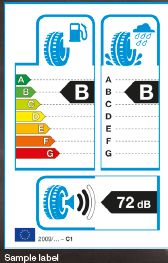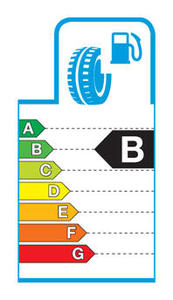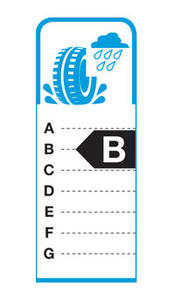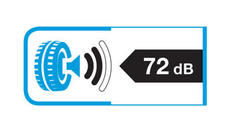Information
Tyre Labelling
In 2012 the European Union has introduced a new tyre label, in order to provide standardised information on 3 specific performances; fuel efficiency, wet grip and external rolling noise.
Tyre labelling for passenger cars and light trucks took effect as from November 2012 for tyres on sale in the EU under European Regulation (EC/ No.1222/2009).
The label must be accompanied on the actual tyre and gives consumers useful information to assist them when purchasing new tyres.
Below you can find an example of the EU tyre label. These graphics on the label may be similar as those already used for household appliances and more recently new cars.
Actual fuel savings and road safety depend heavily on the behaviour of drivers and in particular the following;
Tips
- eco-driving can significantly reduce fuel consumption
- tyre pressure should be regularly checked to optimise wet grip and fuel efficiency performance
- stopping distances should always be strictly respected
Fuel efficiency
Fuel efficiency (Rolling resistance)
Rolling resistance is one of the main resistive forces on a vehicle, which acts as an opposite force to the direction in which the tyre is rolling. The rolling tyre deforms and dissipates energy. The tyre whose rolling resistance is greater, requires more fuel to move the vehicle forward. Therefore rolling resistance influences fuel consumption and the environment directly. On the top left of the label, this shows 7 classes which range from A (most efficient ) to G (least efficient), the grading indicates the tyre’s contribution to fuel efficiency and CO2 emissions.
Wet grip
Wet grip (Braking performance)
Wet grip is one of the most important safety aspects of a tyre. The tyres with excellent grip in wet surfaces have shorter braking distance when driving in rainy weather. There are other important parameters which are also related to safety. However, consumers will be able to check and select for themselves their preferred performance. On the top right of the label, wet grip is also expressed in classes ranging from A (highest performance) to G (lowest performance).
External noise
External noise
Traffic noise is a major factor of nuisance and a very relevant environmental issue. On the lower part of the label, this indicates the level of exterior tyre noise from the vehicle (not the internal noise heard by the driver ), expressed in decibels. The grading indicates the tyre’s contribution to traffic noise and the environment. The label displays sound waves and corresponding levels ranging from 1 (least noise) to 3 (highest noise)
1. sound wave corresponds to the lowest external noise level or the best external noise level performance of the tyre
2. sound waves correspond to the average external noise level or the average external noise level performance of the tyre
3. sound waves correspond to the highest external noise level or the weakest external noise level performance of the tyre
* The new European tyre external noise levels was introduced in November 2016.



